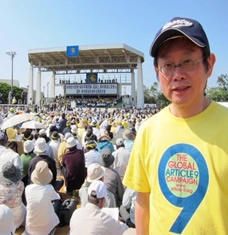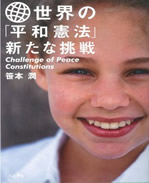REFLECTING ON THE FIRST FIVE YEARS OF THE GLOBAL ARTICLE 9 CAMPAIGN
As the Global Article 9 Campaign is celebrating its fifth anniversary this year of promoting peace constitutions and advocating for the abolition of war in Japan and around the world, we are commemorating this anniversary by looking back at the first years of the Global Article 9 Campaign, how it has changed since 2005, and where it is heading.
 Below is the excerpt of an interview with Sasamoto Jun, Secretary General of the Japan Lawyer's Internationals Solidarity Association (JALISA) on the involvement of Japanese and international lawyers in the Campaign, as well as on peace constitutions in general.
Below is the excerpt of an interview with Sasamoto Jun, Secretary General of the Japan Lawyer's Internationals Solidarity Association (JALISA) on the involvement of Japanese and international lawyers in the Campaign, as well as on peace constitutions in general.
Question: How have Japanese and international lawyers become involved in the Global Article 9 Campaign?
Sasamoto: In February 2005, at the GPPAC Northeast Asia Conference held in Tokyo, many Asian participants talked about the regional impact that a revision of Article 9 would have (...) not only on the Japanese people, but also on all Asian countries. It is in this context that the Campaign was launched.
In November 2005, the Japanese delegation to the International Association of Democratic Lawyers (IADL)'s meeting held in Bulgaria proposed to join the Global Article 9 Campaign.
The response was very positive. European lawyers said that Article 9 was better than the United Nations Charter: while Article 2, paragraph 4 prohibits the use of force as an international principle, Article 51 grants a right to use force. Article 9 of Japan's constitution, however, prohibits all wars and the maintenance of military forces.
We Japanese lawyers participated in a conference (COLAP4) in 2005 in Seoul. We submitted a report on the debate around revising Article 9 of Japan's Constitution. In light of the danger posed by a revision, IADL's President suggested holding an international conference exclusively on Article 9. So, after discussing the idea with Kawasaki Akira of Peace Boat, we decided to hold an international conference on Article 9 in Japan.
Question: After the Global Article 9 Conference held in Tokyo in May 2008, how have lawyers continued being involved?
Sasamoto: In June 2009, IADL held its XVIIth international congress in Hanoi, Viet Nam. We Japanese lawyers brought up the Global Article 9 Campaign for the first time in such a large international lawyers' conference. In its final declaration, the congress explicitly expressed its support for the Global Article 9 Campaign and called on all lawyers and jurists to work for the implementation of a peace clause in every country. [For more about the Congress, click here.]
Question: Now, a few questions about peace constitutions in general: what do you mean when you talk about peace constitutions?
Sasamoto: There are many kinds of peace constitutions: non-military ones like in Japan, Costa Rica and Panama; non-foreign military base constitutions like in Ecuador, Venezuela, and the Philippines. Another type is non-nuclear constitutions, like in the Philippines. Finally, another kind of peace constitution is about resolving conflicts by non-military means, like the Treaty of Amity and Cooperation in Southeast Asia signed by ASEAN.
Question: Does any country currently have an ideal constitution?
Sasamoto: I would say the non-military one is the best. But it is the most difficult to incorporate. Non-foreign military base constitutions allow the existence of the military, which can lead to resolving conflict by force. So, the idea is quite different. And for the non- foreign military bases, they still have their own national armies, like Ecuador or Venezuela.
Question: So if non-military is your ideal type, does any country's or countries' constitution currently reflect that ideal type?
Sasamoto: Panama's constitution refers to the Japanese and Costa Rican constitutions, but maybe there is no ideal type of constitution in the world today. There are maybe about 30 countries without armies in the world, but they have no constitution: like the Vatican or Monaco, they just cannot have an army for financial reasons.
Question: Next question, and maybe this is the opposite side. What are the minimum traits or characteristics of a peace constitution?
Sasamoto: At the minimum, the common factor in all of these kinds of constitutions is conflict resolution by non-military means.
Question: Why do you think it is important to focus on peace constitutions rather than on state's policies?
Sasamoto: National government policies are easy to change through elections or public opinion, but a constitution is more difficult to amend. And a constitution can fix a situation, reflect a cultural situation in a given country. Take Japan for example: most Japanese people take it for granted that the country cannot make war. Though Japan dispatched Self-Defense Force to Iraq, they didn't participate in combat operations. Likewise, people in Costa Rica think it is absolutely natural not to have an army, it is part of their culture. So, constitutions can create a culture of peace. Policies cannot.
Question: And what about the reality: there is often a gap between a state's constitution and its actual policies? Does that challenge the importance of peace constitutions?
Sasamoto: Yes, it is correct, but constitutions restrict policy-making. For example, Japan can dispatch Self-Defense Force to Iraq, but it cannot use force because of Article 9. Or Japan cannot have nuclear weapons, because we have Article 9. Or Japan cannot export weapons because of Article 9. Article 9 can restrict Japan's policies, at least. Yet, there are Self-Defense Forces and US bases in Japan, despite Article 9. I believe that if the idea of Article 9 is spread to other countries in the world, we can come close(r) to the spirit of Article 9. No military, no US bases. Sometime in the future.
Question: For you, what kind of culture or environment fosters the fulfillment of the ideas espoused in peace constitutions?
Sasamoto: Conflict resolution is very important. The way conflict is resolved is important - through dialogue, not by force. I can see this everyday, everywhere. As a lawyer, I am engaged in resolving conflicts everyday - through dialogue and by law. But outside of my law firm, a lot needs to be done in Japan to resolve conflicts peacefully. I think we need to change minds to resolve conflicts through dialogue. We need to start peace education in schools. By spreading peace education in schools in Japan, we can come closer to the spirit of Article 9.
 Sasamoto Jun recently published a new book on peace constitutions. Entitled "Challenge of Peace Constitutions", the book introduces various peace constitutions around the world and looks at how Article 9 of Japan's Constitution has inspired countries to adopt peace clauses, notably in Latin America.
Sasamoto Jun recently published a new book on peace constitutions. Entitled "Challenge of Peace Constitutions", the book introduces various peace constitutions around the world and looks at how Article 9 of Japan's Constitution has inspired countries to adopt peace clauses, notably in Latin America.
For more information about the book, click here (Japanese only).The book can be purchased on Amazon.com here (Japanese only).
This interview is part of a series of interviews with leaders, supporters, and participants of the Global Article 9 Campaign conducted by former Peace Boat and Global Article 9 Campaign intern Jay Gilliam.
Jay Gilliam is currently carrying out research on the Global Article 9 Campaign and peace constitutions around the world. He is completing a Master's Program in Peace Studies & Conflict Resolution at International Christian University in Tokyo, Japan.